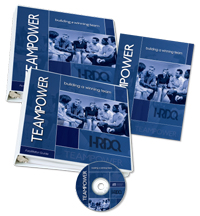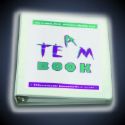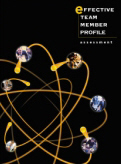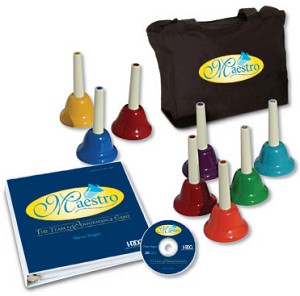|
Team Building Skill
TeamBook consists of 27 activities to improve group functions and achieve effective human relations by providing exercises in the fundamental principles of team building, team building goals and participant guidelines. TeamBook is a collection of ideas and exercises for use by trainers or program designers who are engaged in the effort of helping work groups to develop into teams. Keeping the conditions, goals, and guidelines of TeamBook in mind will assist users to develop from work groups into more effective teams. Section 1: Starters (Ice Breakers) Contains 3 exercises such as "Team Starter" for teams whose members each manage the work of others who are external to the team.
Team Development Activities For Trainers The activities provide the vehicles for team members to enjoy a common experience; explore, discuss, and resolve issues that have arisen; and then apply what they have learned to their work. Additional features provide trainers with resources to make team development easier and more effective, including a program design framework, checklists for use with activities, and an index of games organized by skill (objective). The activities in this collection have been used in many different industries and by those in various job functions, including the military, financial services, higher education, secondary schools, nurses, teachers, IT specialists, pharmaceutical managers and others. Team Development Activities for Trainers addresses a full range of skill areas including: Step-by-step facilitator guidelines: · Alternative Routes · The Amazing Electric Team Leader · Are We a Team? · The Bayeux Tapestry · Build Us a Crane · Candle Snuffing · Choose Your Own Sport · Classic Cars Auction · Cock of the Walk · Communications Audit · CompuSpeak · Cooks’ Dilemma · Creative Weighing Machines · Customer Clusters · Delegation Is Good for You · Describe Your Work Team · Disappearing Golf Balls · Draw Us a Map · The Four Seasons · Go-Carting · Himalayan Saunter · How Do You Manage Your Meetings? · How Healthy is the Patient? · Leadership Styles and Values · Like the Hat? · Managing Boundaries · Motive Power at Work · Music Maestro · News Clues · Noah’s Ark · On Average… · Open Access · Pegging away · Penny Pitcher · Please Join Our Team · Polybricks · Queen’s Time · Sell Us a Sport · Sell Your Team · So What Are You Going to Do About It? · Star Performer · Straight from the Horse’s Mouth · SuperAnt · Symbols of Your Work Team · Team Climate Survey · Team Development Checkers · Team Development Goals · Team Effectiveness Review · Team Leadership Styles · They’re Dancing to Our Tune · Tic-Tac-Toe · Tykes Verses Romans · Viking Chess · Want a Job? · What Do You Advise? · Where Are You Now? · Who Are Our Competitors? Find this team building tool at HRDQ:Click here to visit HRDQ Introduction to Team Building Techniques helps increase motivation, promote unity, strengthen corporate and team culture by using proven team building activities.
Pump Them Up! Activities 35 reproducible workshop activities. 4 reproducible assessments for diagnosing team strengths and weaknesses. 7 additional reproducible assessments for enhancing workshop activities. Pump Them Up! provides 70 hours of team training!
What's My Team Member Style? Assessment What’s My Team Member Style? and the other titles in the HRDQ Style Series™ are based on the well-known research and personality theories of psychologists Carl Jung, William Moulton Marston, and others. Most research has identified two basic dimensions of style, which we refer to as assertiveness and expressiveness. Assertiveness is the effort a person makes to influence or control the thoughts or actions of others. Expressiveness is the effort that a person makes to control his or her emotions and feelings when relating to others. How It Works Uses for What’s My Team Member Style? What’s My Team Member Style? is an excellent way to kick off any team-building training and can be used as a stand-alone tool or as part of a larger program. It is most effective for members of intact teams who are in the training session together. The assessment can also assist team members in identifying work roles that fit with their team member styles. (For more work-role practice, use Deir el-Medina and Team-Work & Team-Roles in tandem with What’s My Team Member Style?
Teambuilders: 10 Adventures in Working Together Decision Making,
Problem Solving, Teamwork, Communication,and Leadership.
TeamBuilders also addresses critical secondary skills such as trust, managing diversity, assertiveness, influence, conflict management, negotiating, and more. Activities may be used independently or paired together as part of team training.
Benchmarks Of Team Excellence Assessment : Get the tool that measures a higher level of team functioning. Benchmarks of Team Excellence reveals important information about the experience and attitudes of those who know the team best — the team members. Benchmarks will help you measure the extent to which teams possess the 6 indicators of excellence:
Benchmarks of Team Excellence was developed as part of an extensive research project that investigated the relationship between various leadership behaviors (visionary leadership behaviors and good management practices) and the level of excellence in the manager's team. A thorough review and synthesis of the literature revealed 6 indicators of excellent work units: alignment, team effectiveness, empowerment, passion, commitment, and results. The 6 indicators of excellence: How it Works; By combining individual scores with the team’s scores, participants get a portrait of their team’s overall level of performance in each of the 6 excellence indicators. Interpretative information provides insight into the ranges and scores. With analysis, discussion, and action planning questions, participants then reflect on and discuss the team’s functioning and how it can improve. Uses for Benchmarks of Team Excellence

TEAMPOWER Program
Great teams don’t just happen. Authentic teamwork is built upon true commitment, trust, collaboration, and competence - qualities that can only be developed with considerable effort over time. TEAMPOWER accelerates the process, helping teams transform from ordinary to extraordinary. This comprehensive and interactive program provides in-depth skill development in the vital areas needed for effective performance, including group development, team roles and responsibilities, problem solving, group decision making, communication, and managing conflict. Teams emerge from the learning experience with a fresh sense of direction and practical strategies for working together better.
Effective Team Member Profile: The Effective Team Member Profile helps individuals understand what it takes to be a viable and potent member of a team — and how their behavior clearly indicates the extent to which they are (or aren't) effective. The 36-item profile focuses on 6 "Effectiveness Factors": · Recognize the importance of individual contributions to team success · Gain insight into one’s effectiveness · Learn ways to improve performance in 6 important areas · Develop a plan to become more effective Theory The Effective Team Member Profile focuses on 6 key elements of effectiveness. The concepts underlying the 6 Effectiveness Factors are derived from a compilation of research including Larson and LaFasto (1989), Parker (1996), Riechmann (1998), Redding (2000), and Rees (1997) among others. How it Works Each individual creates two profiles. The first is based on the individual's own perceptions of his or her effectiveness. The second is created from feedback given by other team members. Finally, action planning assists team members in transferring what they have learned to their day-to-day efforts. Teams may also discuss their collective effectiveness and identify ways to improve overall team performance.

Reproducible Program Materials:
The term "groupthink" has become a standard way of describing a special phenomenon that can and does occur in groups. If a group experiences groupthink, it has developed a set of shared perspectives that may be unrealistic but are strongly supported by the members of the group. The GroupThink Index helps teams gauge the effectiveness of their decision-making progress - and catch hidden tendencies toward hasty, lazy, or self-satisfied group thinking. Overview The phenomenon of groupthink seems to develop as a group becomes more cohesive and less critical of its own decisions. For example, a group may decide on a plan of action that a few of the members propose and support. Without a debate or critical thinking, the rest of the group goes along with this plan because its concern for unanimity and solidarity outweighs its desire to discuss other, and perhaps more valid, points of view.
The author facilitated a team building session with a senior management team. It was the afternoon of the second day and the learning experience had gone exceptionally well. People who had barely spoken to one another before the program now shared their hopes and dreams with the entire team. They had clearly reached a new level of team development, a stage of good feelings, esprit de corps, and closeness. Then the group undertook a standard consensus exercise. It was a survival problem in which a limited number of available items must be used creatively if the group is to survive. The group members approached their work with excitement and determination. They were now a team and nothing could stop them. Unfortunately, they were so eager to agree with one another that they accepted weak rationales for items without thinking critically of challenging the assumptions on which they were based. Of course, the results were disastrous, and they were disappointed with themselves and with their performance. What could have gone wrong? The author sensed it was the new level of cohesiveness that got in their way. They had worked so hard during the previous day-and-a-half that they did not want to disagree over what seemed to be a relatively unimportant project. They went along with one another to preserve the group's unity, and the results were far less than they were capable of achieving. If only there was some way to help them understand the positive and negative effects of cohesiveness. Other than explaining the concept of groupthink, there was no convincing tool. After the session the author resolved to create an instrument that could help groups break out of the pleasant state of good feelings they often achieve. It was important to move them to a state of interdependence where challenges to group members could have the effect of stimulating greater group effort, not tearing down what they had already built. The GTI is used most effectively in the context of a team development intervention. It is appropriate for senior management teams, project teams, cross-functional teams, self-managing teams, and a variety of other teams. Because the concept of groupthink is a more sophisticated notion of what can go wrong in group decision making, it is not useful for all teams. Teams benefiting from this instrument will have a higher level of education, experience, and skill, in addition to being more mature in their interpersonal relationships. The facilitator will need to make a careful assessment of the team and its members before introducing the GroupThink Index.
Maestro a team building training game for employee and management development training. The experiential learning activity is an engaging and interactive way to improve teamwork, team performance, team leadership, and problem solving skills.
Find more team building ideas here Jungle Escape Team Building Game Mars Surface Rover Team Building Game
HRDQ Style Blinkies Light up the room with personality ! Style blinky? What’s a blinky? They’re the latest addition to the HRDQ Style Series, that’s what they are. Cool, light-up buttons you can give to your audience as a learning takeaway. Everyone will enjoy will enjoy wearing their personality “on their sleeve” – or any other part of their shirt. Blinkies are magnetic, so they’re easy to display in workspaces and they won’t harm clothing. These buttons are fun, flashy, and your participants will want them! But in all seriousness, Style blinkies aren’t just about bling. They’re an excellent way for participants to build rapport with others, build style awareness, engage in Style “talk,” and hopefully serve as a friendly reminder that flexing one’s style is the key to effectively interacting with others.
|

















